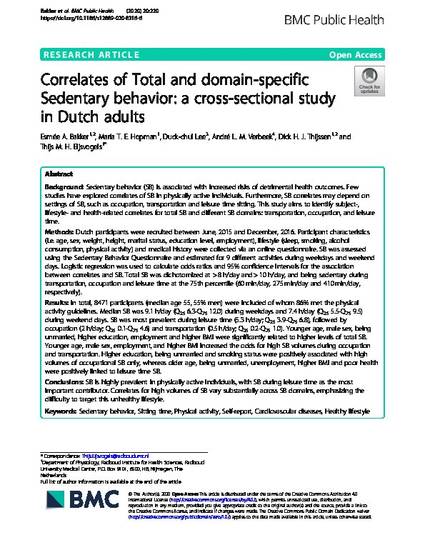
Sedentary behavior (SB) is associated with increased risks of detrimental health outcomes. Few studies have explored correlates of SB in physically active individuals. Furthermore, SB correlates may depend on settings of SB, such as occupation, transportation and leisure time sitting. This study aims to identify subject-, lifestyle- and health-related correlates for total SB and different SB domains: transportation, occupation, and leisure time.
Methods Dutch participants were recruited between June, 2015 and December, 2016. Participant characteristics (i.e. age, sex, weight, height, marital status, education level, employment), lifestyle (sleep, smoking, alcohol consumption, physical activity) and medical history were collected via an online questionnaire. SB was assessed using the Sedentary Behavior Questionnaire and estimated for 9 different activities during weekdays and weekend days. Logistic regression was used to calculate odds ratios and 95% confidence intervals for the association between correlates and SB. Total SB was dichotomized at > 8 h/day and > 10 h/day, and being sedentary during transportation, occupation and leisure time at the 75th percentile (60 min/day, 275 min/day and 410 min/day, respectively).
Results In total, 8471 participants (median age 55, 55% men) were included of whom 86% met the physical activity guidelines. Median SB was 9.1 h/day (Q25 6.3-Q75 12.0) during weekdays and 7.4 h/day (Q25 5.5-Q75 9.5) during weekend days. SB was most prevalent during leisure time (5.3 h/day; Q25 3.9-Q75 6.8), followed by occupation (2 h/day; Q25 0.1-Q75 4.6) and transportation (0.5 h/day; Q25 0.2-Q75 1.0). Younger age, male sex, being unmarried, higher education, employment and higher BMI were significantly related to higher levels of total SB. Younger age, male sex, employment, and higher BMI increased the odds for high SB volumes during occupation and transportation. Higher education, being unmarried and smoking status were positively associated with high volumes of occupational SB only, whereas older age, being unmarried, unemployment, higher BMI and poor health were positively linked to leisure time SB.
Conclusions SB is highly prevalent in physically active individuals, with SB during leisure time as the most important contributor. Correlates for high volumes of SB vary substantially across SB domains, emphasizing the difficulty to target this unhealthy lifestyle.
Available at: http://works.bepress.com/duck-chul_lee/52/

This article is published as Bakker, E.A., Hopman, M.T.E., Lee, Dc. et al. Correlates of Total and domain-specific Sedentary behavior: a cross-sectional study in Dutch adults. BMC Public Health 20, 220 (2020). doi: /10.1186/s12889-020-8316-6.